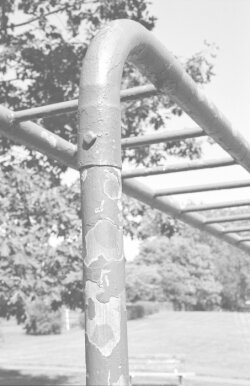Hidden danger: City playgrounds may be hazardous to children
A scraped knee or bumped head may not be the greatest danger your child faces when playing on Charlottesville’s playgrounds. Following up on a tip from a concerned parent, The Hook has learned that at least one city playground contains paint with dangerously high lead levels.
The Hook collected paint samples from three city playgrounds: Meade Park, McGuffey Park, and Pen Park, and sent the collected samples to Analytics Corp., an independent laboratory in Richmond. The results of those tests raise serious concerns about the safety of our public parks.
Of the paint samples from the three parks, two– from Meade and Pen parks– tested positive for lead. But at Pen Park, where large chips of yellow paint are peeling from one swing set and other equipment is badly chipped, the lead level (.058 percent) is below hazard level.
At Meade, on the other hand, various equipment has chipping paint, and according to the test, at least some of it has a lead content of .586 percent, nearly 10 times higher than allowed by the Consumer Product Safety Commission.
In 1978 the CPSC banned the sale of any paint for consumer use containing more than .06 percent lead. According to an October 1996 CPSC report, it also banned “toys and other articles intended for use by children, such as playground equipment, that uses paint with a lead content in excess of .06 percent because they present a risk of lead poisoning in young children.” It further advised that immediate attention be given to equipment with deteriorating paint containing levels of .5 percent or greater. Such as at Meade Park.
According to the CPSC, daily ingestion of just one-tenth of a square inch of lead-containing paint over approximately 15-30 days could result in blood lead levels at or above the level considered a hazard.
And lead poisoning is not something to take lightly: according to the Alliance to End Childhood Lead Poisoning website (www.aeclp.org), “lead affects practically all systems within the body.” It is most damaging to children under age six because it is easily absorbed into their growing bodies and can interfere with the development of the brain and other organs and systems.
At high levels, lead poisoning can cause mental retardation, coma, and death. But even at low levels, the website explains, lead poisoning can “cause reduced IQ and attention span, hyperactivity, impaired growth, reading and learning disabilities, hearing loss, insomnia, and a range of other health, intellectual, and behavioral effects.”
Scott Wolfson, spokesperson for the CSPC, says that though there must be prolonged exposure by ingestion to cause damage– a child would have to come to the park every day for a couple of weeks and eat paint chips– the lead level at Meade Park is high enough for concern.
“There is a physical health hazard to children from accessible lead,” he says. Wolfson says the CPSC would recommend repair of the playground, either by painting over the old paint to seal the lead in, or by stripping the paint completely and repainting.
Since the equipment is old, however, Woolen Mills resident Kevin Cox would like to see it replaced entirely and the playground brought up to modern standards. He says his three-year-old son has cut himself repeatedly on sharp– possibly lead containing– paint chips at Meade, and he says that although he has complained about the park’s shabby condition to the city’s Parks and Rec department, nothing has been done about it.
That, however, may soon change. Pat Plocek, city Parks and Rec director, says Meade Park is next on the city’s “to do” list for playgrounds. Once the new budget goes into effect on July 1, Plocek says, Meade Park will receive entirely new equipment.
As for the current state of the park, Plocek explains that when the City had all the parks tested “several years ago,” none came up positive for lead. But he adds, “We don’t mess around with lead– we take it very seriously.” He theorizes that any lead that might be present at Meade Park would have to have come from early coats of paint exposed by the deterioration of more recent lead-free layers.
Based on The Hook’s findings, Plocek says he’ll have each piece of equipment at Meade Park retested, and any equipment that tests above the safe limit for lead will be removed and replaced immediately.
Until that happens, however, parents of children who regularly play at Meade Park can ease their fears, says the CPSC’s Wolfson, by having their child tested for exposure to lead, a test readily available at any pediatrician’s office.
